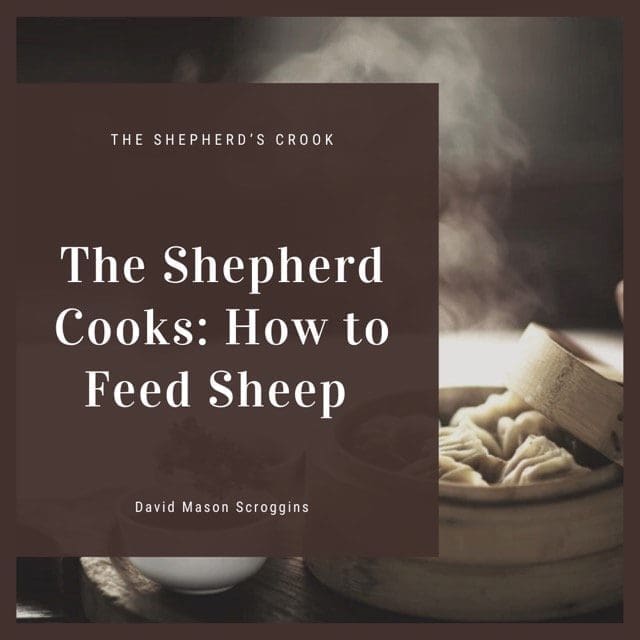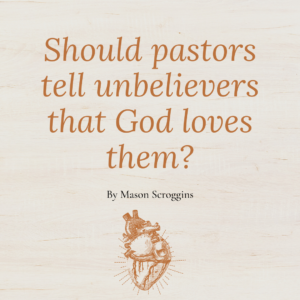Everyone knows that going to the grocery store is not all that it takes to feed a family. You must bring those groceries home. You need to know how to arrange them. Just as imperative is how you cook them. And if you value the finer things in life, how you present and feed them to the family makes all the difference.
When they had finished breakfast, Jesus said to Simon Peter, “Simon, son of John, do you love me more than these?” He said to him, “Yes, Lord; you know that I love you.” He said to him, “Feed my lambs.” He said to him a second time, “Simon, son of John, do you love me?” He said to him, “Yes, Lord; you know that I love you.” He said to him, “Tend my sheep.” He said to him the third time, “Simon, son of John, do you love me?” Peter was grieved because he said to him the third time, “Do you love me?” and he said to him, “Lord, you know everything; you know that I love you.” Jesus said to him, “Feed my sheep. John 21:15–17 (ESV)
A man who will not provide for his family is worse than an unbeliever(1 Tim 5:8). Likewise, Jesus links the love of a pastor to his ability to feed the sheep. If a shepherd truly loves his church he will put in the time and effort to spiritually nourish them every Lord’s day with a feast of God’s word.
There’s much more to feeding a flock of sheep than going to seminary. You might have the utensils and all the ingredients, but how to present that and feed the flock is not always as easy as it looks. Cookbooks don’t make good cooks, cooking does. To simplify things, you can boil down feeding the sheep into three parts. You have explanation, illustration, and application[1].
Explanation
The explanation could be likened to the ingredients. This is getting everything laid out on the table looking at it and understanding what you have before you. Solid exegesis means knowing everything that needs to be thrown in the pot. Nothing more. Nothing less. At this point what the meal is going to taste like is still unknown, but the text is your grocery list. You might even think about this part of the sermon as a hibachi grill. The minister is laying out all the stuff of the text before the congregation. If he’s slick he will build an onion volcano[2] in the introduction too.
Illustration
Then you have illustration. Illustration concocts all these ingredients together at the right time and in the right way. Once you mix them you still have a mess that needs to be cooked and put in the oven. So illustration takes the text that you’re preaching, stirs in all the ingredients, arranges them all together, and then sticks it in the oven. It is getting the meal hot. Biblical doctrines and ethical principles can become abstract. Illustration should be teaching the church what ingredients complement each other. Faith without works tastes gross. And how bitter truth can be without love.
At this stage, the sermon is baking upon the altar like a burnt offering. The glory steam cloud sends a pleasing aroma to the hungry sheep. Whetting the appetite ensures the shepherd that his flock will all be sitting around the Lord’s Table ready when it’s time to give thanks (Eucharist). Excitement should be built around the gift of the Bread of Life. God has given us Christ the living bread that never leaves us to starve. As a child flicks on the oven light to watch the meal come alive so too should the parishioners be having light bulb moments to see how all the ingredients in the text point back to Christ. Before you tell them to dig in they should already desire to because it’s steaming under their nose begging them to be acted upon.
Application
It’s time to eat! Application is showing how to consume the meal. Or better yet, it is actually feeding the meal. This is the time to open up and eat the scroll like Ezekiel (Ez 3:2). Sometimes that means asking the congregation to open their mouths wide and choo-choo or fly the bite in. But just because you have a meal completely cooked and all presented before you does not mean that the sheep know how to eat the meal. They will be thinking, “how does Christ want me to apply this scripture to my life this week.” Everyone knows that children must be taught how to eat. And beyond being taught how to eat there is proper etiquette that needs to be followed to eating the meal. Your speech is to be seasoned with salt, but how much (Col 4:6)? When you are in China you don’t use your fork. You use chopsticks. If you’re eating a steak it’s going to be very difficult to eat it with a spoon. So if the church does not yet understand how to practically apply the word to their lives this week, then they should not be excused from the table. Make sure they leave with plenty of leftovers to take home and they know how to heat them back up again.
What if they choke?
From time to time, the shepherd’s job is to perform a quick Heimlich maneuver. This happens because the lamb is unable to swallow the meat. What he needs is the pure spiritual milk (1 Pet 2:2). If you find that your entire congregation is choking on your preaching it might be symptomatic that it’s not so much choking, but spitting out of the gross preaching that you were offering. Overcooked sermons are like eating burnt pies. And raw meat will make one sick. There are exceptions to this, nevertheless, your flock for the most part should be able to gladly consume what you offer them.
But what about that one that does keep choking over and over? At five-star restaurants when the man starts to choke on the medium-rare steak he has been served the proper procedure is to help out that man and instruct him on how to eat the steak better. Maybe he just needed to slow down. Or maybe he’s just too young to be able to chew the steak up completely. The answer to this problem is not to quit serving steak. When I bring my family to a restaurant I don’t set the bar at the pace of the most incompetent child. Little Henry sits on my lap while I chow down a juicy steak. In the same way, you shouldn’t short circuit your congregation and make them drink milk all the time when most of them are capable of eating a steak. This is where true pastoring comes in to play. A disciple of Christ makes disciples. The pastor will pull this man aside in a loving way and instruct him on how to eat the meat of God’s word. The goal is to get everyone to the highest maturity for consuming the most excellent of cuts. You want a church that has a palate for five-star dishes, not homiletic happy meals. In short, maintain five-star quality sermons while also having an active process for discipling young men and women on how to consume those delectable sermons. Bon Appétit!
[1] Chapell, Bryan. Christ-Centered Preaching: Redeeming the Expository Sermon. Third. Grand Rapids, MI: Baker Academic, 2018, 74-75.
[2] https://www.youtube.com/watch?v=2N7IZ3p8gYQ




